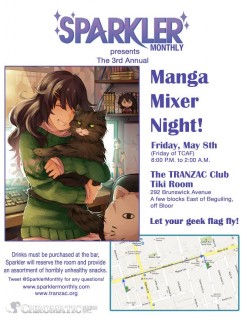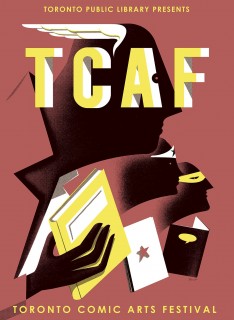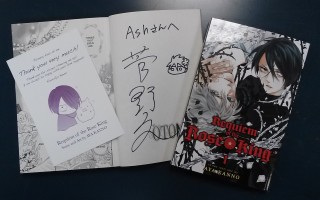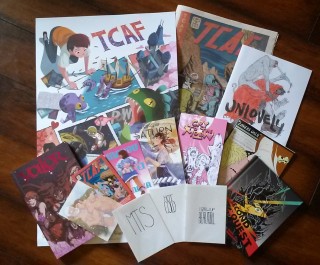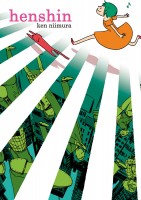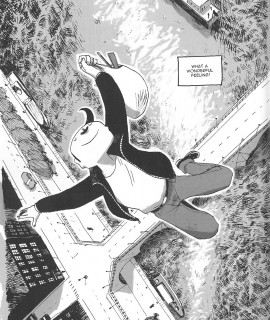2015 marks the third time that I’ve been able to attend the Toronto Comic Arts Festival (TCAF). I generally don’t go to very many conferences, festivals, or conventions unless it’s for work, but I had such a phenomenal experience at TCAF 2013 that it’s become an annual event for me. TCAF is totally worth me pushing through all of my social anxieties and general awkwardness. This year was great, too, and for the most part I handled it pretty well. I don’t know if it’s just that I’m getting used to the trip and generally know what to expect from the event or what, but TCAF’s expansion into more areas of the Toronto Reference Library made the crowds feel less, well, crowded which probably also helped.
I’ve actually been trying to make TCAF a family trip since 2013 and this year it finally happened. Everyone, including the nine-month old, was able to make it to Toronto. We set out from Michigan on Friday and arrived in Toronto in time for me to go to Sparkler Monthly‘s Manga Mixer. I went last year, too, and enjoyed myself, so I was looking forward to it even though I’m not much of a party person. I enjoyed the mixer this year as well and had the opportunity to talk about manga, comics, and all sorts of things with all sorts of people. I was particularly happy to chat with Lissa Pattillo and the rest of the folk at Chromatic Press again. And I met several of my fellow manga and comics enthusiasts in person for the first time, like Linda/animemiz, Ysabet MacFarlane, and Alex Hoffman, which was great. Later on in the evening Jason Thompson showed up and we talked for a bit, which was pretty exciting for me since he played a large role in introducing me to manga. He seemed to know who I was, too, even though we’d never met before.
Actually, people recognizing me or Experiments in Manga after I introduced myself was something that happened several times over the course of TCAF, which was an odd but kind of thrilling experience. (I guess “Ash Brown” is a name that tends to stick with people?) Another odd thing to happen was that a lot of people assumed I was one of the exhibitors or an artist myself. Granted, considering how many creators visit TCAF as exhibitors or attendees, it’s a pretty safe guess for someone to make and still end up being correct much of the time. Anyway. Some of my personal social highlights over the course of TCAF in addition the Manga Mixer: I had a nice conversation with Ryan Sands, said hello to the MASSIVE crew, ran into fellow Manga Bookshelf blogger Sean Gaffney, had the chance to meet Amanda Cosmos, briefly chatted with Jocelyne Allen, and talked with Ken Niimura and Aya Kanno at their respective signings. And there were plenty of other smaller interactions throughout the festival, too.
I like to start off TCAF proper bright and early on Saturday morning by visiting the exhibitor areas. This has a few advantages: the crowds are relatively small and manageable, exhibitors haven’t sold out of anything yet (although, not everything is available for sale right away), and most of the festival programming for the day hasn’t started. I generally have a few tables that I know I want to stop by and a few things that I know I want to check out, but I also wander around to see everything that’s there. For me, part of TCAF is learning about and discovering new things; I always make a point to come home with some comics and artwork by artists whose work I’m completely unfamiliar with. If I could I’d bring home everything that caught my interest. I have to give myself a strict budget for TCAF to keep things from getting out of hand. I focus my purchases on independent creators and small publishers while at TCAF, but I also end up making a very lengthy list of comics and other books to obtain at a later date. Even after it’s over, TCAF continues to influence what I buy. This year I got my hands on almost everything that I really wanted, but there were a few things I’m still kicking myself for missing out on, like Gengoroh Tagame’s new artbook. Hopefully I’ll have the chance to pick some of those things up in the near future, though.
On Saturday, I attended a total of six (six!) panels. I basically found a seat in the Marriott’s High Park Ballroom and didn’t move for the rest of the day. (Should you ever attempt this yourself, I highly recommend bringing your own water and snacks with you.) One of the most challenging parts of TCAF is deciding which programs to go to because it is literally impossible to do everything. There are so many fantastic panels and creators that there are always going to be conflicts. But, rest assured, whatever you choose, it will be great. I have yet to leave a TCAF event disappointed or dissatisfied.
My first panel of the day was “Subscription Comics.” Moderated by Brigid Alverson, the discussion featured Box Brown of Retrofit Comics, Ryan Sands of Youth in Decline, Jordan Shiveley of Uncivilized Books, and Lianne Sentar of Chromatic Press. Although the models are different from one publisher to another, each of them features a subscription service of some sort. (I’m currently a Chromatic Press and Youth in Decline subscriber; next year I’ll probably be a Retrofit subscriber, too, considering the number of comics I buy from the publisher anyway.) The panel’s conversation focused on the benefits provided and challenges presented by subscriptions not just for publishers, but for creators and readers as well. Subscriptions get money to the publisher quickly and can help pay for upfront costs. It can be incredibly useful for publishers to know that there will be definite revenue when planning the year’s finances, too. For creators, publishers’ subscriptions can provide an appealing outlet for experimentation, a way to do something for fun on the side, and not have to worry about marketing and other aspects of promotion. The panelists tended to agree that an ideal subscription service would feature both big and small names. The more well-known artists provide the initial draw for readers and help support the publication of the rest of the comics. Subscriptions can provide the curatorial guidance needed in the astoundingly large world of comics which can frequently be overwhelming, especially for newer readers.
Brigid Alverson was also involved with the next event, serving as the interviewer for Aya Kanno’s Spotlight with Jocelyne Allen interpreting. The discussion largely focused on Kanno’s two most recent series to have been released in English, Otomen and Requiem of the Rose King. She got the idea for Otomen when she realized that a lot of the men around her were otomen, but that in Japan a boy liking girlish things is still looked down upon, more so than a girl liking boyish things. Her editor at the time was a little uneasy about the series because Kanno had never done a comedy manga before; it took about a year to convince him. Being true to oneself is a theme that is particularly important in Otomen, and one that deeply resonates with Kanno. As for Requiem of the Rose King, there is an exaggerated element in Shakespeare’s plays that she doesn’t often see in modern works that she finds very appealing. Kanno described her version of Richard as a mix of all of the good parts of Shakespeare’s Richard, characteristics of the historical Richard III, and some of her own fantasy. Kanno did read a fair number of history books when conducting research for the series, but not much on the time period is available in Japanese, so the visuals of the manga tend to be heavily influenced by Shakespearian stage productions and much of the story comes from within Kanno herself as she creates her own personal interpretations of history. Kanno has always been interested in sex, gender, and sexuality, so it isn’t too surprising that those subjects play an important role in her work; both Otomen and Requiem of the Rose King deal with those subjects in different ways.
Next up was “Gay Comics Art Japan with Gengoroh Tagame,” featuring Gengoroh Tagame, the first commercially successful creator of gay manga, Anne Ishii and Graham Kolbeins of MASSIVE, and Leyla Aker, one of the editors at Viz Media and SuBLime Manga. Tagame was one of the featured guests at TCAF in 2013 and he is an extremely knowledgeable and charming individual, so I was very happy to see him return again this year. The panelists discussed queer comics, gay manga, and BL, the fluidity of the boundaries between the genres, and the usefulness and limitations of labels. It’s becoming more and more difficult to definitively draw a line between gay manga and BL. Many complicated factors influence how a person approaches a particular work: the style of the art, the gender and sexuality of the creator (which in and of itself is very complicated), the emphasis placed on romance or sex, and the intended audience, among many other things. Generally, fifteen to twenty percent of SuBLime’s readership, and up to fifty percent for some titles (usually the romance-oriented manga), are men and Tagame has a large number of fans who are women, so even the boundaries between expected audiences are blurring. Complicating matters even further is the fact that the different categories and genres applied to manga in Japan do not necessarily have exact equivalents to those used in other countries and vice versa. Categorization can be useful for marketing purposes, publishers, and readers, but it can also create situations in which the content or creators are being marginalized or pigeonholed simply because of the label that is being used. Aker mentioned that there were two major BL mangaka whose work is often requested by fans who ultimately did not want to be published by SuBLime specifically for those reasons.
Despite being a huge fan of Avatar: The Last Airbender, I’ve never actually read any of the comics. And so before attending Gurihiru’s Spotlight, I wasn’t particularly familiar with the work of the two Japanese artists who make up the illustration team: Chifuyu Sasaki, who focuses on design, pencils, and inks, and Naoko Kawano, who focuses on design and colors. Along with their agent Akihide Yanagi, who helped to interpret, the two women were interviewed by Deb Aoki. Sasaki and Kawano became friends in college and soon after began collaborating on artwork together. Although they each have their specialty, their creative process has always been a team effort. Previously, they both worked as office ladies and did some local illustration work on the side; it wasn’t until they responded to Marvel’s search for Japanese creators that their career as artists really took off. They still haven’t been published much in Japan—their style is considered “too Western” by some—however, they have found success in other parts of the world. One of the reasons they submitted their work to Marvel was to try to reach an audience that would better appreciate their style. Marvel has never asked them to change how they draw and they have been given a lot of freedom with the series that they have been involved with. In addition to Marvel and Dark Horse Comics, Gurihiru has also worked with Scholastic and Pearson Education as illustrators and colorists. Their two biggest influences when it comes to how they approach their art? Disney animation and Todd McFarlane’s Spawn. One day Gurihiru would like to try creating their own stories, but in the meantime they’re so busy as artists that they haven’t had a good opportunity to develop those skills.
Noelle Stevenson’s Spotlight conflicted with Ed Luce’s Spotlight, which I was also very interested in. But, because Gurihiru’s session went over its time, I was already in the room, and I wanted to be there for the next panel as well, I decided to continue my siege of the High Park Ballroom. Stevenson was on a panel that I attended last year at TCAF and I was looking forward to reading her debut graphic novel Nimona which debuted at TCAF this year, so I was glad to have the chance to hear her interviewed by Robin Brenner (another manga-savvy librarian that I look up to a great deal). Stevenson is an engaging, intelligent, and well-spoken young creator. Topics of the casual conversation included Nimona, working as part of a team as a writer for Lumberjanes, and the importance of diversity in comics. Before being picked up by HarperCollins, Nimona started as a webcomic that was a part of Stevenson’s senior thesis. The first thing she knew about the story was its ending, but she actually began posting the comic online before the script had been finalized. As a result, the comic changed some as it progressed, and additional revisions needed to be made for the print edition. Stevenson first became widely known for her fanart, which is how her agent, who approached her directly, discovered her. Her work on Nimona and as a writer for Lumbarjanes has allowed her to create something of her own which subsequently led to other projects. As Stevenson describes it, “the writing was an accident,” but she is now being hired for her own unique voice rather than as someone to mimic an existing tone or story. She finds it very satisfying to be in the position to create something that isn’t just more of the same, feeling that diversity in comics makes for better stories in addition to challenging readers to expand both their worldviews and their capacities for empathy.
One of the most popular events at TCAF in 2014 was “What Do Women Want? Writing Comics For A Female Audience” and so this year Lianne Sentar facilitated a reprise of the panel. Joining her this time around was Sam Maggs, Sandra Bell-Lundy, Brenden Fletcher, Svetlana Chmakova, and Sydney Padua. The group provided a nice range of perspectives on the subject as the panelists are all involved in different parts of the comics industry: publishing, journalism, syndicated comics, mainstream comics, manga-influenced comics, and webcomics. The panelists argue, and I agree with them, that by expanding the range of stories being told about and for women in addition to increasing the diversity of their representation in comics, men’s stories and representation are inherently expanded and increased as well. Stories aimed at straight, white men are often the default in mainstream media, but if allowed, women-oriented stories can be just as universal. Last year the panel included a lot of angry ranting, but this year tended to be much more positive in tone, a good indication that the state of the comics industry is already beginning to change for the better. The group hypothesized that the Internet has a played a critical role in allowing this to happen. Social media and webcomics in particular have provided platforms for creators to freely express themselves, reach a widespread audience, and form communities and support networks even when working on a comic that is especially niche. The big publishers are paying attention to these developments and taking note of what readers want, but the inertia of a well-entrenched industry used to telling a particular kind of story can be difficult to overcome and there will continue to be missteps. The road may be bumpy, but it is improving, and there are now other viable options for creators and readers outside of mainstream publication, as well.
I thought about going to the Queer Mixer again this year but ultimately ended up hanging out in the city with the family, finding plenty of good food to eat and beer to drink, enjoying the pleasant weather outside, and visiting Toronto’s public parks. Because TCAF starts a couple of hours later on Sunday than it does on Saturday, we were able to sleep in a bit on Sunday morning before heading out for brunch. Afterwards I made my way back to the Marriott and the Reference Library while the rest of the family explored the Royal Ontario Museum. Compared to Saturday, at first it seems like I hardly did anything at all on Sunday since I only attended three panels. But, I also made it to Ken Niimura and Aya Kanno’s signings, and spent some more time in the exhibitor areas talking to and collecting signatures from some of the other creators. The other three-fourths of family wandered around the library for a bit as well, tracking down some of their favorite artists and adding to the pile of comics that were coming back to the United States with us.
My first panel of the day was “Get Published In Japan!,” moderated by Deb Aoki and featuring Yuri Yamamoto (an editor at Akita Shoten for Princess magazine who is working with Aya Kanno on Requiem of the Rose King among other series), Ken Niimura, Abby Denson and independent manga artist Yuuko Koyama (who self-published some work together in Japan), and Gurihiru’s agent Akihide Yanagi. While the panel addressed some of the more technical issues and challenges that confront non-Japanese creators when trying to break into the manga industry in Japan—such as language barriers and the lack of support for submitting materials digitally—much of the discussion actually focused on the importance of the relationship between an editor and creator. In Japan, editors tend to play a much more prominent role in the creation of comics than they do in most other countries; editors are often considered a part of the creative team, and some even act as the writers for the artists they work with. It’s a relationship dynamic which may take some foreign creators, many of whom are used to working more independently, time to adjust to. As Niimura puts it, “Finding the right editor is like finding the right girlfriend or boyfriend,” a good match is required to really make the relationship work. The panelists agreed that one of the most important traits for creators to have is the ability to positively take critique and criticism in stride, always working to improve based on those comments with the knowledge that even if they are severe they are intended to help them better themselves and their work. Of course, the advice that creators receive, even for the same comic, will differ depending on the editor they are working with. Some editor’s in Japan intentionally seek out foreign talent, while others still show some discrimination towards non-Japanese creators. But, as long as a submission to a manga magazine is in Japanese, it will always be reviewed for consideration.
It was then back to the Reference Library for the “Manga Translation” panel facilitated by Robin Brenner and featuring translators Kumar Sivasubramanian (who has done manga translation for Dark Horse and Vertical) and Jocelyne Allen (who has worked with Drawn & Quarterly, Digital Manga, Viz Media, and others) as well as Deb Aoki (who has served as one of the judges for the Manga Translation Battle sponsored by Japan’s Agency for Cultural Affairs). Over the course of the discussion, the panelists identified some of the things that make manga translation particularly challenging, such as sound effects, the size and shape of word balloons and the limited space for text, choosing appropriate gendered pronouns, puns and wordplay, culturally specific concepts and jokes, and so on. Both accuracy and readability are important for any translation; the audience must always be kept in mind since translation choices and tone will change depending on what the publishers and readers want or need. Some series, like Blade of the Immortal, demand a “rawer” translation with much of the Japanese terminology left intact because that is what the audience has come to expect. Different publishers have different policies and requirements for their translations, too. For example, some allow translation notes while others do not. Many manga fans may not realize that the translators ultimately aren’t the only ones responsible for a manga’s translation—adapters and editors, as well as the original publishers and creators, are also involved in the decisions that are made. More than one translator may work on the same series, too, so additional effort is needed in order to maintain a consistent translation over multiple volumes. It’s also worth noting that it’s very rare that a translator has the opportunity to work directly with creators or to ask them questions about their manga. Generally translators don’t know anything more than any other reader and they can be taken by surprise by the manga’s developments, which can present problems for translation.
Although the Comics vs Games showcase has been a part of TCAF for four years now, 2015 was the first time that I had the chance to attend any of its programming, largely because much of it was actually located in the Reference Library this year. At one point in time, my love of games rivaled my love of comics, so I was particularly looking forward to it. “Comics vs Games: Microtalks!” featured eleven speakers: David Calvo, Alfe Clemencio, Amanda Cosmos, David Hellman, Andrew Hlynka, Kim Hoang, Rachel Kahn, Xin Ran Liu, Matthew Ritter, Jason Shiga, and Miguel Sternber. The group included game developers, artists, and aficionados, as well as comics creators, each of whom gave a very short presentation discussing various aspects of comics and games, generally touching upon the similarities and differences between the mediums and what creators working in one could learn from the other. Both comics and games can be a form of storytelling that requires a reader or player to actively engage in the creation of a narrative from disparate images and moments. Of the two, generally games are considered to be more interactive, which greatly impacts the experience of the story, even if it’s a linear one. But the incredibly innovative work being done by Jason Shiga proves that comics can be interactive as well. Art obviously serves a function in comics where it is a critical part of the narrative, but it’s also important in games where the artwork is responsible for creating and establishing a setting and environment. Traditional illustration techniques can be used to inform game art and design, and even three-dimensional games can successfully incorporate two-dimensional artwork and animation.
Believe it or not, the above is just a small fraction of what I could have written about TCAF. Each of the individual panels and spotlights could have easily had an entire essay devoted solely to them; I merely expressed some of my own thoughts and experiences, and touched upon a few and not by any means all of the major themes and topics addressed at the various programs at the festival. TCAF is an absolutely fantastic comics event. If you ever have the opportunity to attend, I highly recommend it. I know that I certainly plan on returning every year that I possibly can.


